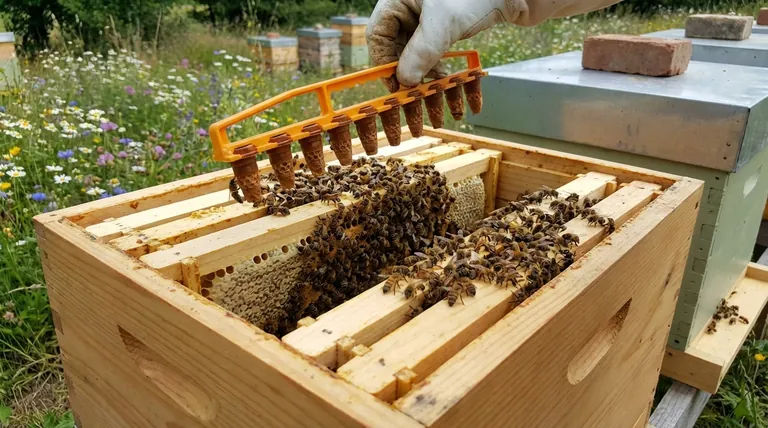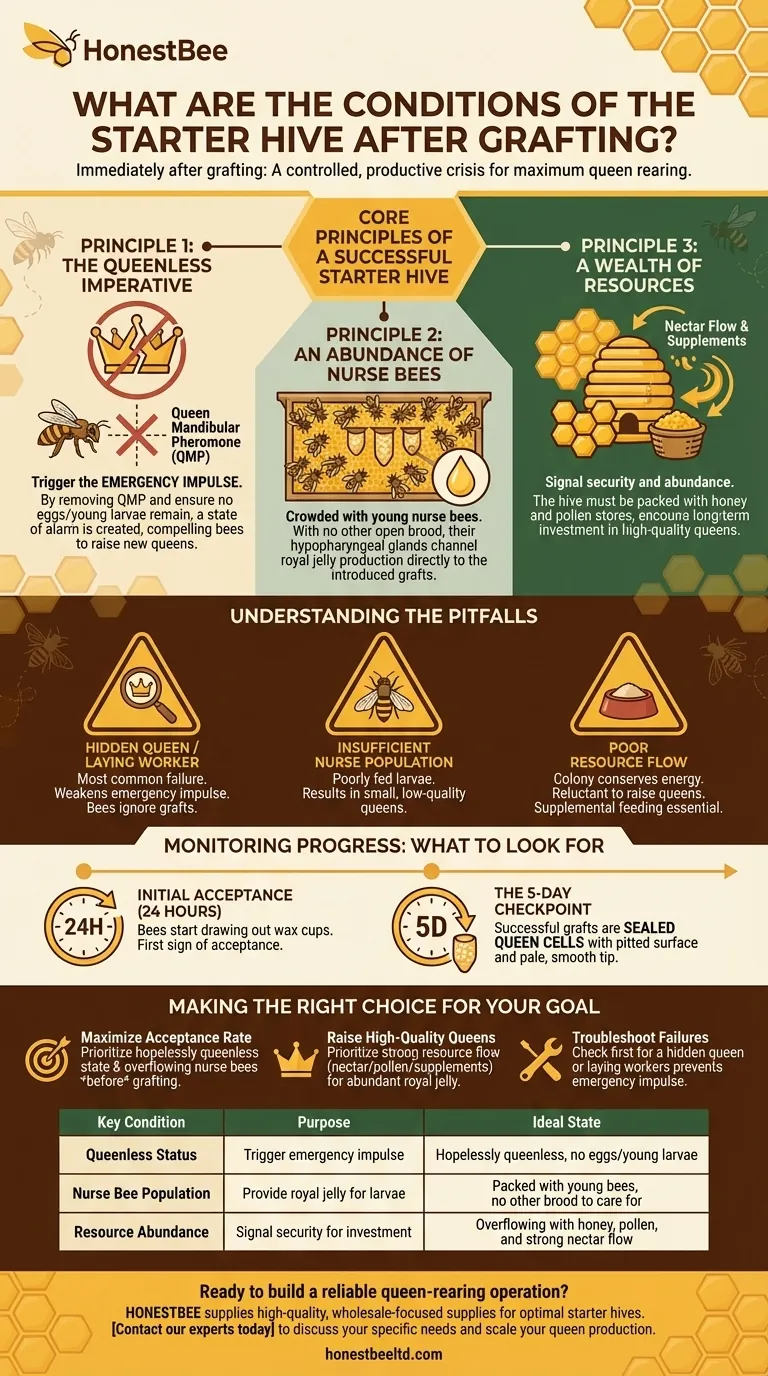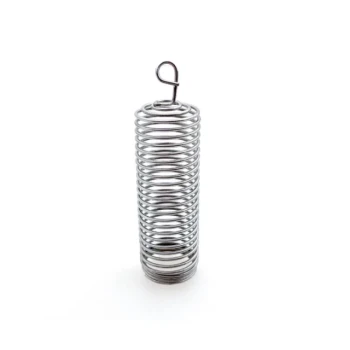Immediately after grafting, the ideal starter hive is in a state of controlled, productive crisis. It must be hopelessly queenless, packed to capacity with young nurse bees, and overflowing with honey and pollen. This environment is specifically engineered to channel the bees' powerful emergency impulse into one single task: accepting your grafts and raising them as new queens.
To maximize graft acceptance, you are not just placing larvae in a box; you are engineering a biological response. The goal is to create a hive so overwhelmed by the absence of a queen and an abundance of resources that the bees' focus is intensely and exclusively directed to the grafted cells you have provided.

The Core Principles of a Successful Starter Hive
A successful starter hive isn't created by accident. It is the result of manipulating three core biological triggers within the colony to ensure your grafts are not just accepted, but are fed lavishly from the moment they are introduced.
Principle 1: The Queenless Imperative
The entire system hinges on the emergency impulse. A colony with a laying queen produces Queen Mandibular Pheromone (QMP), which signals that all is well.
By making the starter hive queenless (and ensuring no eggs or young larvae from a previous queen remain), you remove this pheromone. This creates a state of alarm, biologically compelling the bees to raise a new queen immediately to ensure the colony's survival.
Principle 2: An Abundance of Nurse Bees
Grafted larvae require enormous quantities of royal jelly to develop into queens. This can only be produced by young nurse bees whose hypopharyngeal glands are fully active.
A successful starter is deliberately crowded with these young bees. Because there is no other open brood to care for, their entire focus and royal jelly production is channeled directly into the queen cells you have introduced.
Principle 3: A Wealth of Resources
Bees will not invest in raising new queens if they perceive a threat to their own survival. The hive must feel wealthy and secure.
This means it should be packed with stores of honey and pollen, and ideally have a strong external nectar flow. This signals abundance, encouraging the bees to make a long-term investment in raising multiple, high-quality queens.
Understanding the Pitfalls
Even with a perfect plan, issues can arise. Understanding the common failure points is critical for troubleshooting and ensuring a high success rate.
A Hidden Queen or Laying Worker
This is the most common reason for total graft failure. If a virgin queen, an old failing queen, or laying workers are present, the "queenless" signal will be weak or nonexistent. The emergency impulse will not trigger, and the bees will ignore your grafts.
Insufficient Nurse Bee Population
If the starter hive has an aging population with too many foragers and not enough young nurse bees, it will lack the workforce to properly feed the larvae. Grafts may be accepted but will be poorly fed, resulting in small, low-quality queens.
Poor Resource Flow
During a nectar dearth, a colony's instinct is to conserve, not expand. Even a queenless hive may be reluctant to invest energy in raising new queens if it lacks sufficient stores or an incoming food source. In these conditions, supplemental feeding with 1:1 sugar syrup and a pollen patty is essential.
Monitoring Progress: What to Look For
After setting up the starter hive and introducing the grafts, you need to know what success looks like.
Initial Acceptance (24 Hours)
A quick check after one day should show the bees have started to work the cells. You will see them starting to draw out the wax cups, which is the first sign of acceptance.
The 5-Day Checkpoint
Five days after grafting is the key moment of truth. Successful grafts will now be sealed queen cells or very close to being sealed.
These developing cells will have a characteristic sculpted, pitted appearance on their surface. The very tip of the cell, however, will be made of pale, smooth wax, indicating the final stage of construction before sealing.
Making the Right Choice for Your Goal
Your specific goal will determine which environmental factor you need to prioritize the most.
- If your primary focus is maximizing graft acceptance rate: Make the hive hopelessly queenless and overflowing with young nurse bees at least 24 hours before introducing the grafts.
- If your primary focus is raising high-quality queens: Ensure a strong, continuous flow of nectar and pollen (or feed supplements) to guarantee the larvae receive abundant, high-quality royal jelly.
- If your primary focus is troubleshooting failures: Your first and most critical check should be for any sign of a hidden queen or laying workers, as their presence will prevent the emergency impulse.
By understanding and managing these biological triggers, you transition from simply grafting to intentionally engineering high-quality queens.
Summary Table:
| Key Condition | Purpose | Ideal State |
|---|---|---|
| Queenless Status | Trigger emergency impulse | Hopelessly queenless, no eggs/young larvae |
| Nurse Bee Population | Provide royal jelly for larvae | Packed with young bees, no other brood to care for |
| Resource Abundance | Signal security for investment | Overflowing with honey, pollen, and strong nectar flow |
Ready to build a reliable queen-rearing operation? HONESTBEE supplies commercial apiaries and beekeeping equipment distributors with the high-quality, wholesale-focused supplies needed to create and maintain optimal starter hives. From durable grafting tools to essential feeding supplements, we provide the equipment for success. Contact our experts today to discuss your specific needs and scale your queen production.
Visual Guide

Related Products
- Nicot Queen Rearing Kit for Beekeeping and Grafting in Nicot System
- Plastic Chinese Queen Grafting Tool for Bee Queen Rearing
- Retractable Chinese Queen Rearing Grafting Tools Equipment
- Jenter Queen Rearing Kit Complete Set for Bee Breeding
- No Grafting Queen Rearing Kit: System for Royal Jelly Production and Queen Rearing
People Also Ask
- What is essential for successful queen rearing in beekeeping? Master Genetics & Boost Your Apiary's Health
- What should be done to ensure grafted larvae are well-fed? Master the Principle of Abundance for Queen Rearing
- What happens if a larva is grafted too late? Avoid Scrub Queens and Failed Rearing
- Can anyone use Queen Rearing with JZBZ? A Beginner-Friendly System for All Beekeepers
- How can beekeepers start a honey bee breeding program? Build a Superior, Resilient Apiary



















